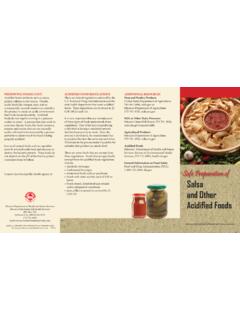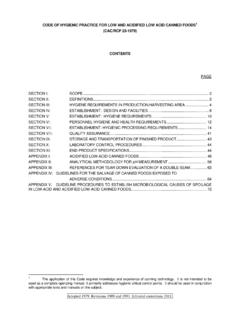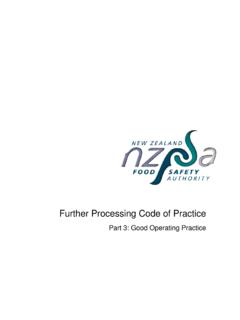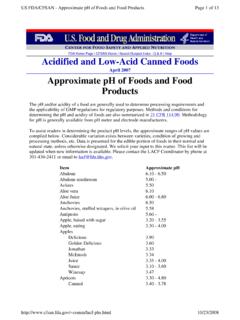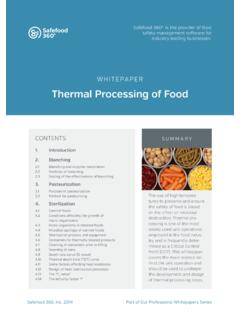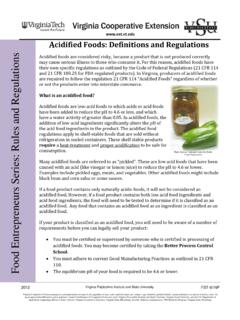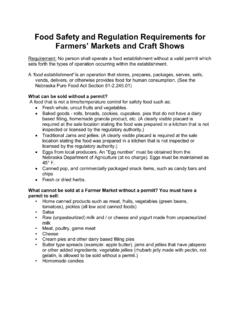Transcription of Thermal Processing - Mississippi State University
1 1 Thermal ProcessingCanning and Aseptic Processing2 COOKING To make food more palatable, improve taste: Alteration of color, flavor, texture Improved digestability Not a preservation technique but: Destroy or reduce Inactivation of enzymes Destruction of toxins Baking Broiling Roasting Boiling Stewing Frying3 Commercial Sterilization Operation in which product is placed in a hermetic container ( canned foods), heated at a sufficiently high temperature for a sufficient length of time to destroy all microbial and enzyme activity (Note -"commercial sterility" implies less than absolute destruction of all micro-organisms and spores, but any remaining would be incapable of growth in the food under existing conditions). Severity of treatment can result in substantial changes to nutritive and sensory characteristics4 Definitions Low- acid foods acid foods Acidified foods pH Aw Disinfection Sanitation Sterilization Commercial Sterilization5 Methods of sterilization In-package sterilised, in which product is packed into a container, and the container of product is then sterilised eg canned , eg some bottled products, retort pouches UHT or Aseptically processed products, in which the product and the package is sterilised separately, then the package is filled with the sterile product and sealed under sterile conditions eg long life milk, tetrapack or combibloc fruit juices and soups etc6 Commercial sterilizationDestroys both vegetative cells and spores of pathogenic & spoilage microorganisms that would be capable of growing in the product under normal storage conditionsTypes of Products.
2 Retorted Aseptically packagedCommercially Sterile Foods Primary objective:Destroy the most heat resistance pathogenic spore-forming organisms botulinumin products > pH Secondary objective:Destroy vegetative and spore-forming microorganisms that cause spoilage. Spoilage spore-formers are usually more heat resistant than pathogenic spore vs. Low acid Foods Foods can be classified on the basis of pH> pH are low acid foods< pH are acid foodsWe also need to know that if the Aw of food is < , it can be classified as acid at ph> Processing times and temperatures are lower for acid foods -microorganisms are more easily destroyed in an acid environment -C. botulinumspores cannot germinate below pH of Information neededheating processfor heat process Heat resistance of Rate of heat penetration Sensory/quality of product Heat resistance of Heating conditions pH and composition of food Size of the container Physical State of food material10 Heat resistance of Refer to Ch.
3 1, Sect. Table Characteristics of Clostridium botulinum Which organism is used to determine heat penetration in low- acid foods? What are the parameters used for this? Which organism is used to determine heat resistance in acid foods? What are the parameters for this?11 Classification of foods by pH Low- acid (pH> ) acid (pH< ) High acid ( <pH< ) High acid , high solids (jams)12 Heat resistance of and spores Low- acid Clostridium botulinum acid Bacillus thermoacidurans13 Rate of heat penetration Type of product Agitation of container Retort temperature Size of container Shape of container Type of container14F The time, in minutes, at a specified temperature required to destroy a specific number of viable cells having a specific z-value. 15F0 Sterilization value or sum of lethality rate that will insure commercial sterilization orequivalent minutes at 250 F to get 12D Fo= Sum (1/t)16 Lethality curve for canned L.
4 Monocytogenesin crabmeat (Rippen, 2002)175-D Process5 D process= time/temperature process that will reduce the Bacillus stearothermophiluspopulation by 5 log for acid (< pH ) canned Process12 D process= time/temperature process that will reduce the Clostridium botulinumspore population by 12 log for low acid (> pH ) canned botulinumspores100 spores/can12 D processC. botulinumspores10-10spores/can(1 in 1010 chance)192021 Gonzalez et al, 2002. Electronic J Env, Agric, food Chem22 Retorted Foods Product processed in the package can, flexible pouch or glass Retorts (Pressure processors) Still Rotary Hydrostatic cooker (pressure provided by a 40 50 feet of head pressure) Processing time depends on heating the most slowly heating part of the Processing -Canning The usual heat transfer fluids are: saturated steam water steam -air mixture Retorts may either be: vertical horizontal still agitating batch continuous 24 OPERATIONS IN CANNING Inspection of incoming raw materials food preparation (thawing, cleaning, washing, sorting, grading, peeling, trimming, slicing or dicing for vegetables and fruits.)
5 Meats and fish may be tempered, boned, trimmed, diced, minced or sliced etc. Blanching Filling the container Exhausting Sealing the container Heat Processing Cooling Incubation and quality control checks Labeling, palletizing, warehousing and dispatch SimplotAustralia25 Blanching methods Steam blanching-less loss of water soluble nutrients leaching -oxidation of product becomes a problem Water blanching-fast process due to a better rate of heat transfer severe on nutrients effective washing process blanch water can be used to transport the raw materials to the next stage of the process Microwaves-very expensive and complex equipment is required -low leaching losses Hot Gas-expensive -hot gas from a furnace is blown down through the product along with team which reduces dehydration and increases the heat transfer rate 26 Filling At this stage the food is placed into the container.
6 Underfillinggives a large headspace. Large headspaces result in the following: Low vacuum if heat exhaust is used. Mushiness of the contents due to excessive movement inside the can. Contravening the Pure food Act Regulations due to underrilling. Overfilling produces excessively small headspaces, resulting in the following: Low vacuum if steam flow closure is relied on for vacuum. Swelling of can due to hydrogen production. Under Processing if the process depends on agitation to mix the contents during Processing . Springiness or distortion of can. Increased chance that food may be trapped between the can lid and body with the production of a faulty seam. The cans are periodically weighed on line, headspaces, drained and net weights are determined on the finished products in order to check the adequacy of the filling process. 27 Automatic filler282930 Golden Circle Exhausting aims to remove air from the package before closure.
7 Correct exhausting will: Remove all gases from the headspace which will minimisestrains on seams during retorting. Remove oxygen, otherwise ether corrosion, oxidation and discolourationwill result. Give a vacuum on cooling to give space for the gases which are formed on storage. There are three exhausting methods available: HEAT EXHAUSTC ontents are heated before sealing. This is ideal for products containing lots of trapped air. Final temperature depends on closing temperature and headspace. STEAM INJECTION also referred to as STEAM FLOW CLOSUREThis flushes the headspace out with a jet of steam just before closing. This method is more effective where products are packed in hot brinesand syrups and where a large headspace exists. MECHANICAL EXHAUSTUses a vacuum pump to remove air from the package. food is filled at low temperatures. This method is useful for foods which trap a greatdeal of air.
8 A vacuum gauge may be used on a cooled can to determine the vacuum of a can. The minimum acceptable pressure is about -23kPa. Desirable vacuum will vary for different products33 Retort Operation-Containers are loaded into baskets. -The retort lid is sealed. -Venting stage -Air trapped inside the retort is removed prior air is present at a given pressure the temperature inside theretort will be lower than that attained by steam mixture of air and steam may stratify leading to cool spots where there is air. This mixture is a less efficient heat transfer medium than steam alone. Air in the retort cuts down the heat penetration of steamby insulating the cans and can accelerate external corrosion. When venting is completedthe venting valve closes and pressure begins to build up in the retort. When process temperature is reached the thermometer and pressure gauge readings must agree.
9 High acid foods (pH less than ) are usually processed at low pressures of around acid foods (pH greater than ) are processed at 73 or 103kpa. 34 RETORT OPERATION The time from when the steam is turned on to when the process temperature is reached is the come-up time. Once this has finished the process begins. Process timeis from the end of the come-up time to the commencement of cooling. During coolingthe steam is turned off and water is added to the retort immediately to prevent overcooking. There are two methods of cooling; for small cans at temperatures less than 116 C atmospheric cooling may be cans with a diameter greater than 6cm or processed at temperatures greater, than 116 C pressure cooling is pressure coolingthe pressure around the containers is maintained by compressed air during the addition of water. The water addition causes the steam to condense and the pressure outside the package dropssuddenly.
10 As the internal pressure inside the container does notdrop until the contents cool, seam distortion may occur if the external pressure is not kept high. At this stage can seams are very fragile and cans must be handledvery carefully. All water used for coolingheat processed foods must be chlorinated to disinfect it in case water is sucked into the canduring of retorts36 Still Retorts Pressure vessel Batch-type Nonagitating Vertical or horizontal With or without crates (crateless)37 Diagram Vertical Retort with Utilities38 Vertical Cratelessretort3940 Horizontal retort41 Loading a vertical retort42 Picture of Divider PlateCrate4344 Crateless45 Still Retort with OverpressureOverpressure Pressure in excess of normal pressure at a given temperature May now have air introduced to retort during Processing as well as coolingPurposePurpose Maintain container integrityMaintain container integrity Internal pressure developed during Processing Internal pressure developed during Processing is greater than pure steam pressureis greater than pure steam pressure46 Overpressure Applications Plastic containersPlastic containers Flexible pouchesFlexible pouches Metal traysMetal trays Glass jarsGlass jars47 Continuous Retorts Still and agitating retorts may be batch or continuous.
